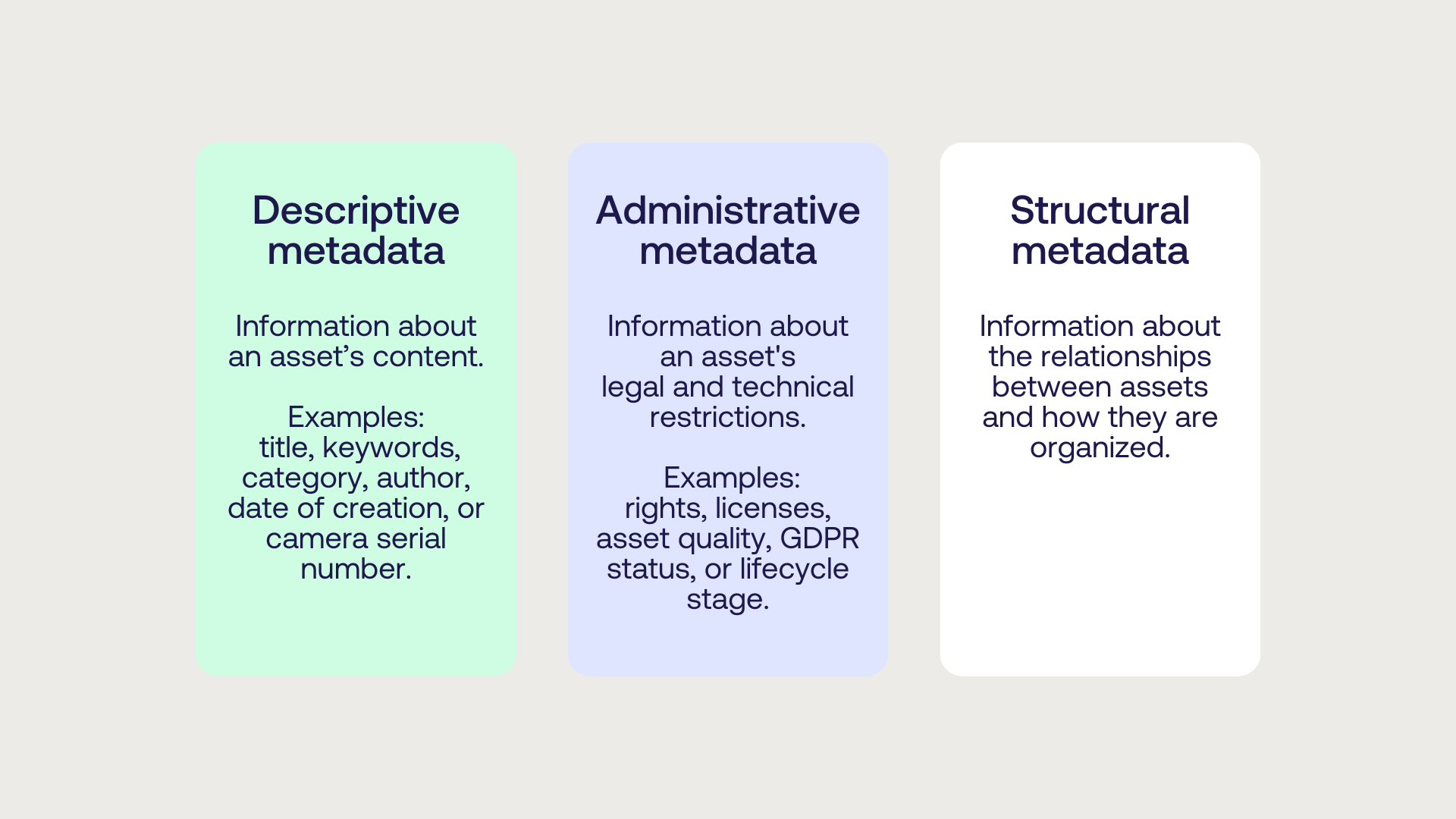
Metadata is much more than simple labels attached to digital files, it's the key to efficiently managing and leveraging digital assets across an organization. When effectively managed, metadata provides the foundation for robust data organization, access control, and streamlined workflows, transforming digital assets from mere files into valuable resources.
This article explores what metadata is, why metadata management matters, and what essential practices your team should consider - from metadata standards to governance and quality control - to maintain a reliable and efficient content ecosystem, unlocking the full value of your digital content items.

What is metadata?
First, before we get into the specifics of metadata management, let’s have a closer look at what metadata actually is. Explained in short, metadata is data about data, offering information about a specific file, a collection of files or the relationships between these. Within the Digital Asset Management (DAM) space often specifically image metadata, it can be anything from keywords and descriptions to EXIF data, time and dates, version history, and much more.
Sometimes, this data is present from the file’s inception; other times, it's added or adjusted later. Either way, it's an essential part of the file's content, and when managed effectively, it can increase the value and Return on Investment (ROI) of content items.
While some organizations pay little attention to metadata, others save precious resources and increase overall control over their media files by optimizing their processes for metadata management.
Learn more: How to find the right keywords for your business: Interview with Clemency Wright

Three types of metadata
Since metadata is a broadly used term, it can be helpful to look at three different types of metadata - Descriptive, Administrative, and Structural – and their relevance for metadata management:
1. Descriptive metadata
Descriptive metadata refers to information about the asset’s actual content. It could be:
- keywords
- content categories
- embedded information like the author’s name and contact information,
- the asset’s date of creation,
- a camera’s serial number.
With appropriate processes for metadata tagging, descriptive data can easily be added to content items, enabling people to quickly locate media files, make advanced searches in massive image collections, or communicate information about specific assets.
Learn more: Macros - the fastest way to apply metadata to your digital assets
2. Administrative metadata
Administrative metadata allows for more advanced management of digital assets, including
- information about their legal and technical restrictions,
- rights,
- licenses,
- asset quality,
- lifecycle stage, and much more.
These forms of metadata are often customized to fit the relevant industries. For example, an e-commerce company may include information about campaigns and release dates, while an entertainment company may focus more on copyright, talent approval status, or image consent.
While administrative data is important for information sharing, it’s also a central component of metadata-driven workflows, often playing the part of antecedents - or triggers - of desired results.
3. Structural metadata
Structural metadata refers to data used to describe the structure of stored resources and the relationships between them. It's commonly used in machine processing and works in the background to ensure a smoother end-user experience.
Oftentimes, structural metadata is compared to the overview of book chapters, with its main purpose being to provide an overall structure to its contents.
By implementing a solid metadata structure, the process of metadata management is simplified, since a lot of the essential information is already incorporated into the structure. This can, for example, be relationships between metadata fields, the file’s place in the content hierarchy, and so on.
/dam-expert-service-oystein.jpg)
What is metadata management?
Metadata management, also called metadata governance, refers to the strategic framework that defines how an organization manages and maintains metadata across its digital assets. It involves setting rules and procedures to ensure that metadata is created, stored, and managed consistently.
Effective metadata management is essential to maintain data quality over time, ensure compliance, and maximize the value of their digital assets over time.
A solid metadata strategy should address who is responsible for metadata, how it should be organized, and what standards and practices should be followed to keep metadata accurate and relevant.
It typically includes the following elements:
Roles and responsibilities
Roles and responsibilities should be assigned for managing metadata across teams, designating specific responsibilities for creating, reviewing, and updating metadata. Training users in the usage of the DAM system and its metadata is another vital element for successful metadata management.
Metadata standards
Metadata standards are established guidelines that define how metadata should be structured, labeled, and used within a DAM system. Adopting a recognized metadata standard ensures that data is consistent, interoperable, and easily understood across different platforms and departments. These standards make it easier to maintain data quality and simplify metadata management routines.
Common image metadata standards include:
-
Dublin Core: Widely used in libraries, museums, and arts and culture institutions (GLAMs), Dublin Core provides a simple yet effective set of terms for describing digital resources.
- IPTC: The International Press Telecommunications Council (IPTC) standard is commonly used for images, especially in journalism and media. It includes fields for copyright, location, and author information.
- EXIF: Primarily used in photography, EXIF metadata provides technical information about images, such as camera settings, date, and location.
- XMP (Extensible Metadata Platform): Developed by Adobe, XMP is widely used and highly versatile due to its support for all types of multimedia files and many capabilities for custom configuration. With XMP one can easily map metadata and use custom metadata fields, allowing for the incorporation of industry specific standards and routines.

Your free guide to metadata governance
How to stay in control of your metadata - three important questions to ask yourself when establishing metadata governance.

Data quality control
Regularly review metadata, ensuring accuracy, completeness, and relevance to help prevent issues like outdated tags, inconsistent naming conventions, or duplicated metadata.
Compliance and security
For organizations with regulatory requirements, such as GDPR or copyright laws, metadata management helps ensure compliance by tracking usage rights, consent, and other legal information. Access to sensitive metadata should also be limited through implementing role-based access control.
Data analytics and change management
As an organization’s needs evolve, so do its metadata requirements. Therefore, a structured approach to managing changes is needed. Routines can involve monitoring system usage, analyzing how users search for content and what specifically they search for, updating image metadata to more accurately reflect actual use.
This data driven approach ensures that metadata remains relevant and valuable even as the content repository grows and changes.
Learn more: Best practices for metadata tagging

The importance of metadata management
A DAM system usually sits at the core of your organization’s content ecosystem and is the central repository for digital content used by a variety of departments in- and outside your organization. The very purpose of a DAM is to be the single source of truth to find all types of content, new and old, and to easily reuse content in meaningful ways, while keeping track on usage rights and approval states, access rights, or content lifecycle stage.
To maintain this role as a single source of truth, a clear metadata management strategy is essential to help ensure consistency, accuracy, and relevance. Keep in mind:
- Planning is the basis content organization.
- Metadata is the key to using your content effectively.
- Metadata management is what keeps your asset collections up-to-date and usable over time.
Learn more: DAM trends - embracing DAM 3.0 for effective content operations
The benefits of metadata management
Active metadata management enables you to construct and enhance automatic metadata-driven workflows for e.g. revoking, publishing, or sending digital assets with little to no human interference. Additionally, files with appropriate and up-to-date metadata are easier for people to search for, find, and work with, increasing overall control, re-usability, and ultimately value of assets.
Managing metadata in a strategic way also increases the value of your third-party DAM integrations such as Content Management Systems, Product Information System, or Collection Management Systems, since images including their metadata can be smoothly accessed and shared across connected systems without the risk of version confusion, unauthorized use, or duplication.
Make metadata manageable with the right DAM
Contact us to discuss your metadata challenges and see how the right DAM can help. We’ll explore your needs and guide you toward a structured approach - no commitment, just insights.
/metadata-tagging-best-practice.jpg)

/ai-autotagging-dam-fotoware-1.jpeg)